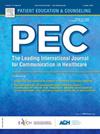Implementation of a patient decision aid for discharge planning of hospitalized patients with stroke: aprocess evaluation using a mixed-methods approach
IF 2.9
2区 医学
Q2 PUBLIC, ENVIRONMENTAL & OCCUPATIONAL HEALTH
引用次数: 0
Abstract
Objectives
To promote shared decision-making (SDM) during discharge planning of patients with stroke, a patient decision aid (PtDA) was implemented in seven Dutch hospitals. This mixed-methods process evaluation assessed: 1) PtDA use, 2) the SDM process, 3) facilitators and barriers influencing health care professional (HCP) adoption of the PtDA, and 4) HCP experiences with the PtDA.
Methods
Rates of PtDA use were derived from hospital registries and PtDA log data. SDM levels in consultations were quantitatively assessed using OPTION-5 (score range 0–100); the SDM process was analyzed qualitatively. Facilitators and barriers were identified via the MIDI questionnaire. HCP experiences were explored through interviews.
Results
PtDA use varied across hospitals, with 10–96 % of patients receiving it and 27–100 % of those ultimately using it. OPTION-5 scores were low in both pre-implementation (n = 68, median:0, Q1-Q3:0–0) and post-implementation consultations (n = 49, median:0, Q1-Q3:0–15). Barriers included lack of whole-team engagement and limited recognition of PtDA benefits. Frequent PtDA use was associated with HCP confidence and self-efficacy in SDM.
Conclusions
Successful PtDA implementation in stroke care requires whole-team engagement, emphasis on PtDA benefits, and enhancing HCP confidence and self-efficacy in SDM.
Practice implications
Highlighting positive SDM outcomes and patient benefits may encourage HCPs to adopt the PtDA.
实施患者决策辅助出院计划的住院卒中患者:使用混合方法的过程评估
目的为促进卒中患者出院计划中的共同决策(SDM),在荷兰7家医院实施患者决策辅助系统(PtDA)。这种混合方法的过程评估评估了:1)PtDA的使用,2)SDM过程,3)影响卫生保健专业人员(HCP)采用PtDA的促进因素和障碍,以及4)HCP使用PtDA的经验。方法PtDA使用率来源于医院登记和PtDA日志数据。使用OPTION-5(评分范围0-100)定量评估咨询中的SDM水平;对SDM过程进行了定性分析。通过MIDI问卷确定促进因素和障碍。通过访谈探索HCP经验。结果各医院使用sptda的比例各不相同,接受sptda治疗的患者比例为10 - 96% %,最终使用sptda的患者比例为27 - 100% %。在实施前(n = 68,中位数:0,Q1-Q3:0-0)和实施后咨询中(n = 49,中位数:0,Q1-Q3:0-15), OPTION-5得分均较低。障碍包括缺乏整个团队的参与和对PtDA好处的有限认识。频繁使用PtDA与SDM患者的HCP信心和自我效能相关。结论PtDA在脑卒中护理中的成功实施需要全队参与,重视PtDA的益处,增强HCP在SDM中的信心和自我效能感。实践意义强调SDM的积极结果和患者获益可能会鼓励HCPs采用PtDA。
本文章由计算机程序翻译,如有差异,请以英文原文为准。
求助全文
约1分钟内获得全文
求助全文
来源期刊

Patient Education and Counseling
医学-公共卫生、环境卫生与职业卫生
CiteScore
5.60
自引率
11.40%
发文量
384
审稿时长
46 days
期刊介绍:
Patient Education and Counseling is an interdisciplinary, international journal for patient education and health promotion researchers, managers and clinicians. The journal seeks to explore and elucidate the educational, counseling and communication models in health care. Its aim is to provide a forum for fundamental as well as applied research, and to promote the study of organizational issues involved with the delivery of patient education, counseling, health promotion services and training models in improving communication between providers and patients.
 求助内容:
求助内容: 应助结果提醒方式:
应助结果提醒方式:


